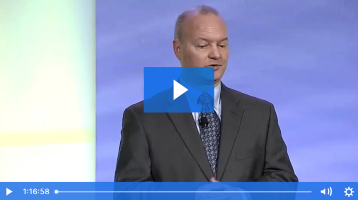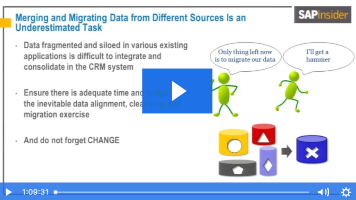7 Tips for a Successful CRM or CXM Initiative
When it comes to CRM and CXM-related initiatives, a lot should happen BEFORE addressing the technology
The older your company is, the tougher your CRM or CXM project might be – but it doesn’t have to be that way.
If you are like most older organizations, you have all kinds of “home-grown” ways of doing things. You’ve cobbled together a patchwork of data sources and reports. You’ve customized things over the years, and no one is even sure why you do certain things the way that you do – they’ve just “always been done that way.” What is in your legacy system can lead to problems when it comes time to implement a new CRM system.
“A very, very young company typically has a much easier time of implementing in general than an old company with many years and much legacy, because they’ve simply got this huge number of business rules and agreements of strange kinds that they somehow need to cope with,” Christian Elgaard, Director & IT Advisor, Implement Consulting Group, said during a recent chat with the SAPinsider Customer Experience Management (CXM) team. “So, this is really something that you should try to address very early in the process and try to trigger this discussion about, ‘How would we be working if we weren’t considering all the legacy stuff we are carrying with us?’”
Explore related questions
That is just one example why CRM or CXM projects can fail. When it comes to CRM specifically, Elgaard says he sometimes sees customers undergo multiple CRM implementations, because they say, “SAP didn’t work, or Salesforce didn’t work, or Microsoft didn’t work.” Perhaps the sales reps say the tools just don’t work for the way they do their jobs. “So, they say, ‘We’ve got to buy something else,’” Elgaard said.
Best-of-breed technology is not to blame. “You can take any of the top CRM suites and implement them successfully in any company,” Elgaard said. The problems stem from what happens BEFORE the technology piece is addressed.
To help companies succeed, Elgaard suggests customers focus less on the technology, and more on people and process. “Problems won’t disappear by implementing technology,” he said. Thousands of hours are spent exploring vendors and discussing detailed requirements when the discussion should have been completely different, Elgaard said.
Elgaard suggests customers explore a benefits realization process. Here, SAPinsider offers some strategies for better CRM and CXM project outcomes based on our conversation with Elgaard.
- Instead of “what we used to do”, think “What should we be doing?”
“I find it very important to address the legacy in a very early stage because what we very often see is that the whole task of migrating whatever it is that you have today onto the new platform or solution is driving a lot of complexity into the project,” Elgaard said. Companies often try to hold onto “old” data and processes that no longer really fit, and it defines how they work with the system moving forward (which can set it up to fail). “The more you can leave behind or somehow manage it in another way other than having to bring it into the new CRM or CXM solution, the better your possibilities of making a clean cut and sticking to standard.” But it does require a great amount of change in behavior. Rather than saying, “This is what we used to do,” Elgaard advises wiping the board clean and starting over again, asking the question, “What should we be doing?” Then, take a look at your legacy and see what you can do to make it available without compromising what you agreed was the best way in moving forward. - Make sure you understand what your company really needs.
Elgaard said he had one client that had several departments with customer service functions that they wanted to merge. “To do so they needed to create a customer 360-view because they had all sorts of systems with different kinds of data in it and they want to bring it together,” he said. “Somebody came to the conclusion, ‘Customer 360 — that’s CRM,’ — so they went out and bought CRM because they thought that was what they needed for the purpose. But what they really needed was some sort of portal.” Elgaard said whenever he speaks to a company about CRM or CXM, he typically asks them what they understand about CRM and CXM solutions, and what picture they have about CRM and CXM. - Technology will not solve your problem, even when every single requirement of a project is delivered.
One of the reasons CRM projects go wrong is that there is a huge gap between the request that’s being put forth by the business, and what it is they wish to achieve with it, Elgaard said. “They are very quickly coming to the conclusion that whatever problem it is they have it can be resolved if only they get this CRM solution, but it seems as if they completely forget everything else that has to they have to bring in place,” Elgaard said. “They haven’t really connected the dots in order to deliver those benefits. They’ve just made a decision to implement some software and then they sit down and wait for the benefits to play out in front of them.” It rarely goes that way, because in order to reap those benefits you need to make a lot of other adjustments in your organization, in your behaviors, and in your way of working with clients, he said.
- Develop a benefits realization process and make it measurable
What we tend to see is somebody defining a purpose and concluding that this purpose is delivered through these project deliverables, and that is typically some sort of functionality that is needed,” Elgaard said. Elgaard said you have to dig one step further, into what he called the “black hole of benefits realization.” He outlined a benefits realization process, which indicates that in order to deliver your intended purpose, you have bring with it certain benefits that are measurable. Additionally, new behaviors are needed. For example, it could be a new way sales reps are organized or work in the field. “We have to change the way we behave,” Elgaard said. You also must have new competencies. “We can’t just expect that people can jump in and do everything in a new way from Day 1,” he said. “We have to make sure they are capable in doing that by bringing in the necessary competencies.” You should start from the purpose, and then try to go back and ask, What are the benefits that are associated with this purpose? And what are the competencies that we need to do so? Achieving the purpose doesn’t come from a new system alone. “You have to start connecting the dots all the way through,” he said. “It’s a very good way of qualifying requirements because if you can’t connect the dots from the requirements to the purpose then it’s obviously not something that’s really important.”
- If your goal is to improve the customer experience, make sure you create a framework for measuring that, too
Today’s organizations are focused on the customer experience, and delivering omnichannel services is one of the keys to thriving in today’s mobile world. If your goal for implementing a CRM or CXM solution is to improve the customer experience, start by creating a framework that allows you to measure your performance in general, and the service that you deliver to your customers through all these different channels. “If you aren’t capable of somehow measuring that, then it’s difficult to find the right level of customer satisfaction,” Elgaard said. “Customer satisfaction tends to be something where everybody just wants to deliver as well as possible to everyone. We’re trying to achieve a situation of perfection; in reality, that drives a huge cost.” Elgaard said to start by trying to understand what drives customer satisfaction and come to a conclusion on where you want to be in terms of the customer satisfaction level you want to achieve. “Do that in a granulated way,” he said. - Bring new processes into your employees’ daily ways of working
One of the reasons CRM or CXM initiatives often fail is poor user adoption. “I think it’s in our nature; we feel safe with what we know,” Elgaard said. “It’s always easier to keep working the way you’re used to.” Elgaard said to be careful about putting too much effort into training – rather, bring the new processes into your employees’ daily ways of working, so that they aren’t dealing with both new technology and new processes all at once. Elgaard suggests trying to rehearse the new reality, beforehand. For example, if the sales reps are going to have to change the way they conduct visits, provide them with some relatively simple steps they can use to start facilitating the new methods beforehand. That way, once the implementation is complete, “they are just getting their tool for what they’ve already been doing for a while,” he said. “Whereas the other way around, they would be accustomed to work in a completely different way with a completely new system. That’s often just too much.” After you’ve gotten the team up to speed on the new system and methods, make sure you keep them on track and enforce it, so they don’t slowly slide back into their old ways of working. - Strike a balance between finding something you can quickly deliver that demonstrates the value of the new solution vs. a 12-18-month project
“The trick here is really to find the level where people are getting enough out of using the system for whatever it is you want them to use it for,” Elgaard said. “It’s very dependent on what you come from. If you come from one CRM system or CXM solution where you are used to working a certain way and you really rely on that, then it’s more difficult. If you’re coming from Excel sheets and deposit notes, it’s easier to break it down into smaller pieces and take one piece at a time. But you always have to be very focused on delivering something that people find attractive to use. Because otherwise you’ve already lost the battle.” If you do things in phases, you have to make sure that the users see value in phase 1, otherwise, “it’s very hard to get them to buy into phase 2 because you’ve already lost them.” The trick is to find a good balance between finding something you can deliver very quickly (so users don’t have to wait 12-18 months for the project to end) but ensuring it’s something where they can see quickly that the system will be of value to them. “If you can deliver that without taking the whole scope that’s something you should really go for,” Elgaard said. You can demonstrate the value quicker, get people on board, and avoid the waste that can come with a big bang, because often many features that are implemented are never used.






